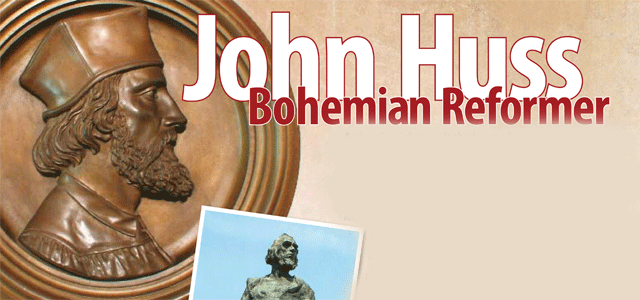
John Huss lived only half as long as many Australians expect to live. He was born between 1369 and 1373 and by his thirties was becoming a national hero. When he was burned at the stake in 1415, Prague University declared him a martyr. Even today, six centuries later, ripples of his influence are still visible.
peasant’s son, avid student
Bohemia, a province of Czechoslovakia, is regarded as the home of the gypsies, so we define a “bohemian” as “a person with artistic or intellectual tendencies or pretensions who lives and acts without regard for conventional rules of behaviour” (Macquarie Dictionary).
A son born to peasant parents in the Bohemian village of Husinec, near the city of Prachatitz, was named Jan, which, in English, we render as John.
In a sense, John was a true bohemian: “intellectual” and prepared to disregard “conventional rules of behaviour.”
John of Husinec “inherited from his widowed mother habits of piety and study, but his higher education was delayed by the necessity of doing menial tasks for a living,” according to historian J T McNeill. However, John finally made it to university and there he shortened his last name to Hus. (Many English histories now add an s, hence we know him best as John Huss.)
Before the dawn of the 15th century, Huss had completed his master’s degree at Prague. His future seemed bright: within a few years he was lecturing in theology, ordained as a Catholic priest, appointed rector of the university and preacher at the Bethlehem Chapel.
how to get martyred, quickly
When Leighton, our son, graduated with a Bachelor of Business degree and began work for a large accounting firm in Sydney, he taught us many new words. Some we remember by their abbreviations: for instance, CLM.
Two decades ago it was a Career Limiting Move to be seen by management without a suit coat, even in the lift that serviced the high-rise building. It was also a CLM to leave one’s desk at 5 pm; valued employees worked overtime, unasked and without additional pay.
John Huss needed a mentor to advise him about CLMs during the first 15 years of the 15th century. From our vantage point it is obvious Huss made tactical errors that curtailed and then terminated his career.
An ambitious priest should have realised the peril of preaching in the language of the people. Isn’t religion a mystery rightly understood only by those properly trained and duly authorised?
Isn’t that sense of mystery best preserved by worship services conducted in a “sacred” language unknown to the masses? Isn’t it perilous for people to understand the simplicity of the Christian faith and the directness of their access to God?
Huss made a second CLM at the Bethlehem Chapel by focusing on the Scriptures. There were many themes he could have safely emphasised: indulgences, the authority of the pope, purgatory and transubstantiation, to name a few. Even in the vernacular, there was plenty for a preacher to say that was 100 per cent acceptable. Why trouble people with the idea that the Bible presents Christ as “the way and the truth and the life”?
Huss made a third grievous mistake by comparing the church of the New Testament with the church of his era.
The teachings of Jesus in the Gospels, the stories in the Acts of the Apostles and the content of the New Testament letters depict a faith that saves, is vigorous and transforms the believer’s life.
Reform has often been seen as revolt when it seeks to recover the living faith and dynamic practice of early Christianity.
Huss came to be regarded by leaders of both church and state as a “critic,” a rebel.
These three CLMs were bad enough, but Huss was also nurturing links with other Reformers. His teachers had introduced him to 14th-century leaders in the Czech reform movement. There was a growing sense in the nation that moral reform was essential and preaching in the vernacular helped to move it forward. Huss was already partial to the thought of Englishman John Wycliffe when Jerome of Prague, in 1401 and again in 1406, brought more of Wycliffe’s theological and reformist works to the city. Huss’s sermons at the Bethlehem Chapel showed he was reading and accepting at least some of the less-radical ideas expressed by Wycliffe.
political troubles
The University of Prague employed many German teachers whose nominalist ideas opposed the philosophical realism of Wycliffe and the Czech teachers.
In due course, 45 articles drawn from Wycliffe’s writings were condemned on academic grounds. The Germans retreated, some to found the University of Leipzig, but such conflicts located Huss even more visibly in the reformist camp. Even so, if Huss had stopped attacking clerical vices and abuses in his sermons, he might have retained the support of his archbishop and other friends who became bitter enemies when they were called to defend themselves against charges of heresy.
It was a particularly difficult time for the church throughout Europe; for one thing, it was unclear who was the legitimate pope. If birds of feather flock together, John Huss was increasingly seen as flying with the wrong flock.
Even King Wenceslas lost patience when Huss opposed the way indulgences were being sold to raise money for a crusade against antipope Gregory XII.
Political unity was seen as a value that must be preserved at all costs.
Sigismurd, the brother of King Wenceslas, was king of Hungary, king of the Romans and Holy Roman Emperor.
He believed that both heresy and papal schism must be eliminated. How to do it? Call a meeting of the powerbrokers of Europe. So, in 1414, the Council of Constance was convened. Wenceslas was threatened with an interdict for seeming to tolerate heresy. It would have been a CLM for the king to refuse to send John Huss to Constance.
all is well?
Sigismund gave John Huss “safe conduct”
to the Council of Constance and the Bohemian Reformer gladly accepted the Emperor’s word at face value. Huss arrived in Constance during November 1414 but, even then, he failed to implement a lesson he might have learned from his earlier troubles: he dared to lead worship services in the very city in which the council was being held. No wonder he was arrested, then imprisoned. Once the council had formally condemned Wycliffe’s writings, it was easier to declare Huss a Wycliffite, meaning Huss also was a heretic. No heretic was entitled to legal representation nor could a heretic defend himself in an open court.
John Wycliffe had died in 1384.
The Council of Constance decreed Wycliffe’s bones were to be exhumed and burned. The Council also burned John Huss at the stake on July 6, 1415.
He died “with great fortitude,” in the attitude of prayer.
outcomes
A leader of the early Christian church named Tertullian wrote that “the blood of martyrs is seed.” Certainly, the burning of Huss in 1415, and the burning of Jerome a year later, failed to quench the reforming impulse in Czech society.
It took until 1428 for the opposers of reform to dig up Wycliffe’s bones in England, burn them and scatter the ashes on the Swift River. There were awful wars in the Czech nation, sometimes between rival reforming factions.
Slowly, painfully, four issues became clearer.
The first of these related to the words of Jesus recited in the Communion service: “Take and eat; this is my body”
and “Drink from it, all of you” (Matthew 26:26, 27). The followers of Huss were called Hussites; they came to believe firmly and teach widely that both priest and people were to partake of the bread and the wine.
Margaret Aston puts it well: “The other three points were free preaching of the Word of God; the call for all priests from the pope downwards to give up their ‘pomp, avarice and improper lordship’; and the correction of public mortal sins” (The Christian World, page 168).
a Catholic’s perspective
Of Paul Johnson’s many books, my favourite is A History of Christianity, acclaimed as “masterly” and “a reliable if hard-edged story of the public church.” Johnson notes that “from about 1080 there had been frequent instances of the Pope, councils and bishops forbidding not only vernacular translations but any reading at all, by laymen, of the Bible taken as a whole.” As a Catholic, Johnson thinks that in some ways “this was the most scandalous aspect of the medieval Latin Church.” To scrutinise the Bible “became proof presumptive of heresy—a man or woman might burn for it alone.”
Johnson adds: “From the end of the 14th century the availability of the Bible to the public became the central issue between the Church, and its critics, such as the Lollards and Hussites” (page 273).
As recently as 1920, Huss was still making an impact on the Catholic church. A group of dissident priests formed the Czechoslovak Hussite Church promoting such reforms as use of the vernacular in the liturgy and voluntary clerical celibacy. Today all of us can learn from John Huss, the stalwart martyr who rated faithfulness to God above the demands of his earthly career, and even life itself.









